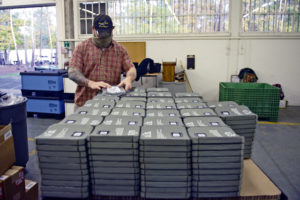
The U.S. military began incorporating ceramic plates into their body armor in the early 1990s. Since then it has been used in every iteration of military protective vests.
U.S. Air Forces in Europe and Air Forces Africa is in the process of evaluating 150,000 of its ceramic ballistic vest plates in coordination with Air Force Materiel Command.
“The plates come through the logistics readiness squadron, and from there we bring them to the production line the contractors have set up,” said Senior Master Sgt. Ryan Love, 86th LRS materiel management flight chief. “They unbox each asset and screen about 10,000 a week.”
The screening process starts by unboxing all the shipped crates. The contractors get them in order to be screened then put through the X-ray system. The X-ray scans for internal cracks in the plates that can’t be detected by visual inspection. Once the plates are deemed serviceable they are marked accordingly and repackaged to be sent out to Airmen across USAFE-AFAFRICA.
“I don’t want anyone to be in a situation where they have to use these plates, but it’s really good to know when you do deploy, these plates can save your life,” Love said.
So far the checks have been successful by having a low discrepancy rate. Out of 10,000 plates, only 60 have been marked unserviceable. All unusable plates will go to the Defense Logistics Agency Disposition Services. The old plates can be used as training gear depending on the level of damage.
USAFE-AFAFRICA is one of the major commands in the Air Force running X-ray checks. U.S. Army Tank, Automotive and Armaments Command, in conjunction with AFMC, performs a majority of non-destructive equipment testing and sets the groundwork for the Air Force to begin doing such testing.
“We get to set the standards for the Air Force,” Love said. “This has been really successful, and we’ve proven that our LRS team can handle mass volumes of equipment.”
Inspections for USAFE-AFAFRICA are planned in two phases with an estimated completion of phase one in December.


